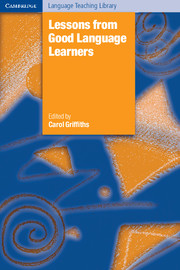Book contents
- Frontmatter
- Contents
- List of contributors
- Acknowledgements
- Editor's overview
- Prologue
- Reflections
- Part I Learner variables
- Part II Learning variables
- 12 Vocabulary and good language learners
- 13 Grammar and good language learners
- 14 Functions and good language learners
- 15 Pronunciation and good language learners
- 16 Listening and good language learners
- 17 Speaking and good language learners
- 18 Reading and good language learners
- 19 Writing and good language learners
- 20 Teaching/learning method and good language learners
- 21 Strategy instruction and good language learners
- 22 Errors correction and good language learners
- 23 Tasks and good language learners
- The learners' landscape and journey: a summary
- Index
21 - Strategy instruction and good language learners
Published online by Cambridge University Press: 11 August 2009
- Frontmatter
- Contents
- List of contributors
- Acknowledgements
- Editor's overview
- Prologue
- Reflections
- Part I Learner variables
- Part II Learning variables
- 12 Vocabulary and good language learners
- 13 Grammar and good language learners
- 14 Functions and good language learners
- 15 Pronunciation and good language learners
- 16 Listening and good language learners
- 17 Speaking and good language learners
- 18 Reading and good language learners
- 19 Writing and good language learners
- 20 Teaching/learning method and good language learners
- 21 Strategy instruction and good language learners
- 22 Errors correction and good language learners
- 23 Tasks and good language learners
- The learners' landscape and journey: a summary
- Index
Summary
An aspect of teaching/learning methodology which has attracted a great deal of debate over the years is the issue of strategy instruction. A major premise of the research on the strategies of “good” language learners initiated by Rubin (1975) is that the strategies used by successful learners of languages can be taught to students who are struggling to learn a new language, thus making them better language learners. In the 30 years since Rubin's article, the effectiveness of strategy instruction has been questioned (for instance, Vann and Abraham, 1990). Nevertheless, others have developed well-recognised strategy instruction models (such as Chamot, Barnhardt, El-Dinary and Robbins, 1999; Cohen, 1998; and Grenfell and Harris, 1999), and research has shown that, under the right conditions, strategy instruction can be effective (for instance, Nunan, 1997; O'Malley, 1987).
Thirty years ago, it was commonly believed that “good” language learners used learning strategies while “bad” language learners did not. This fallacy was exposed by studies that compared effective and less effective language learners and found that both used learning strategies, often the less effective learners using as many strategies as the more successful language learners (O'Malley and Chamot, 1990). Further research examined the quality of learning strategy use and found that strategic learners have metacognitive knowledge about their own thinking and learning approaches, a good understanding of what a task entails, and the ability to orchestrate the strategies that best meet both the task demands and their own learning strengths (see Anderson, this volume).
- Type
- Chapter
- Information
- Lessons from Good Language Learners , pp. 266 - 281Publisher: Cambridge University PressPrint publication year: 2008
- 14
- Cited by



